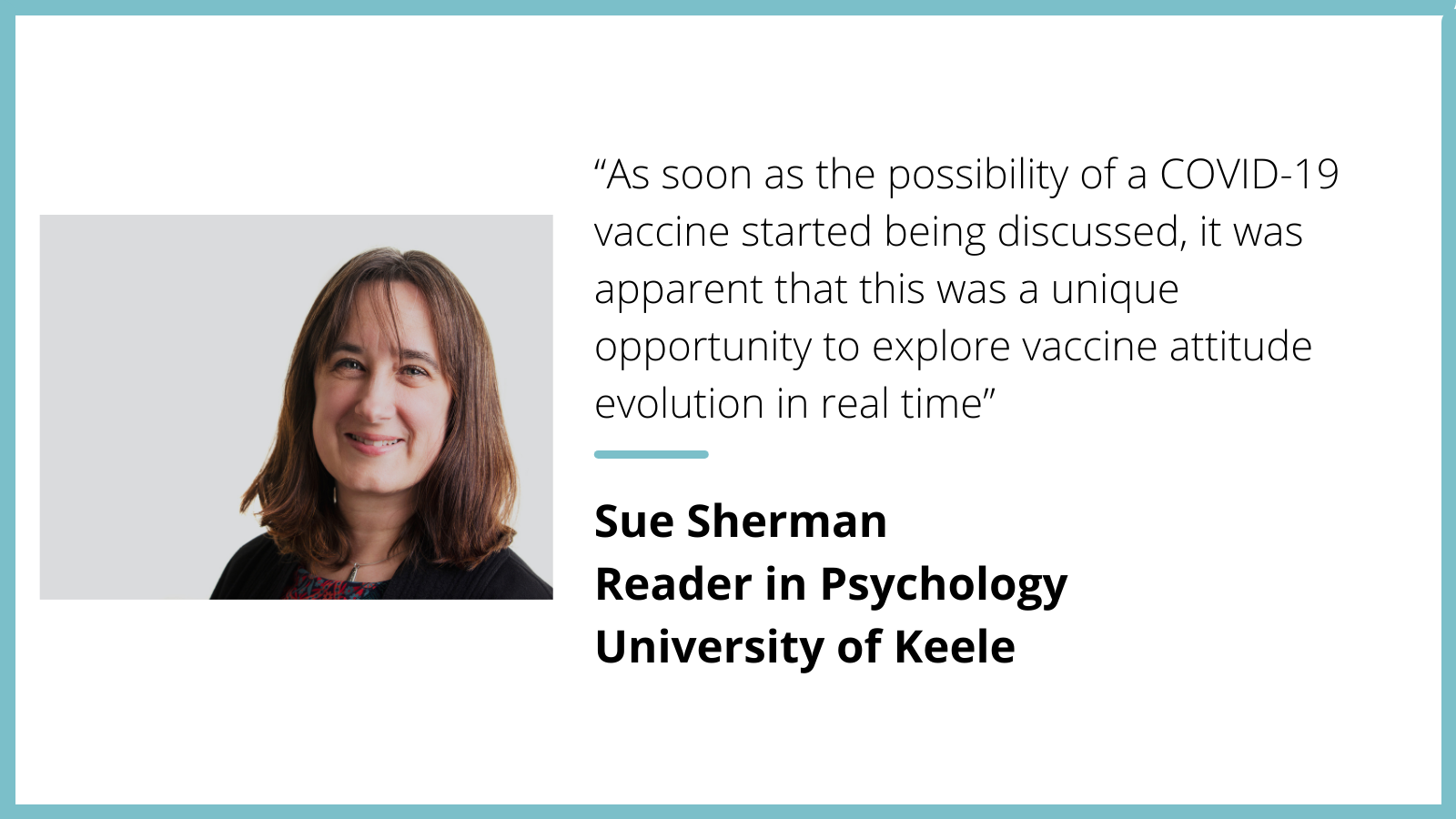Understanding attitudes towards COVID-19 vaccination before and after vaccine development and rollout.
Posted 2022-06-21 12:02:32 by Sue Sherman

Dr Sue Sherman reflects on the importance of rapid funding and collaboration for her and her colleagues’ research on attitudes towards COVID-19 vaccination and the impact it had.
How it began
The start of the pandemic was an interesting and fast-moving time to be a behavioural science researcher and especially one interested in vaccination. Before then, my interest had been in human papillomavirus (HPV) vaccination, but as soon as the possibility of a COVID-19 vaccine started being discussed, it was apparent that this was a unique opportunity to explore vaccine attitude evolution in real time. I floated the idea past a colleague at Keele University (Professor Julius Sim) and I also made contact with some colleagues at King’s College London (Dr Louise Smith, Professors Nick Sevdalis and James Rubin), and Public Health England (Professor Richard Amlôt) some of whom it transpired, were already thinking along the same lines. After an unsuccessful bid to the heavily oversubscribed UKRI COVID funding pot, we applied to our universities who each saw the potential of the work and very quickly gave us some money to take it forward.
Pooling our resources enabled us to employ two research assistants (Megan Cutts and Hannah Dasch) and to carry out three waves of data collection: a cross sectional survey in July 2020, while COVID-19 vaccines were still in development; one in January 2021, after they had started being rolled out in the UK; and a longitudinal follow-up to the January survey in October 2021, when everyone in the UK had been offered the vaccination.
Outputs and impact
So far, the work has generated 4 publications in press, 2 under review, and a further 2 in preparation. The first of these papers (Sherman, Smith et al, 2021 ), published online in November 2020, has amassed 411 citations to date and the survey materials we developed have been used by researchers across the world. It has also had impact beyond academia, with some early examples being:
- October 2020: It was cited in the Royal Society/British Academy Rapid Review “COVID-19 vaccine deployment: Behaviour, ethics, misinformation and policy strategies".
- November 2020: A joint press release between Keele University and KCL, led to widespread media coverage of the findings and reached an estimated 27 million people.
- December 2020: It informed the Scottish Government’s COVID-19 Vaccine Comms strategy
- December 2020: It informed the Hertfordshire Behaviour Change Unit document “COVID-19 Vaccination: Reducing vaccine hesitancy Review & Recommendations"
Recipe for success
We didn’t explicitly do anything to engage with policy makers, but the following ingredients were key to achieving impact:
- Finding the right collaborators – I didn’t know any of my KCL and PHE collaborators before the project but was recommended to contact them by another colleague I discussed my ideas with. So, although most of us had working relationships with one or two other members of the team before we started, we hadn’t worked together as a team before. During our frequent early meetings, as well as designing survey materials, we were also figuring each other out. I hope they would agree that we all got pretty lucky with each other!
- Related to 1, having collaborators who were well connected helped us to think strategically about what questions we should include in our materials at each stage. Richard was the Head of Behavioural Science in the Emergency Response Department at Public Health England (now UK Health Security Agency) and James was a regular participant in the UK Government’s Scientific Advisory Group for Emergencies (SAGE) during the pandemic.
- Further related to 1, recruiting the right research assistants – Hannah and Megan were invaluable to the team, and we couldn’t have done the work without them.
- Rapid funding – We had participant costs, research assistant time costs and we donated our time to the project. While we weren’t successful with external funding, responsive funding was provided by both Keele and KCL and enabled us to get one of the first academic surveys into the field, which in turn enabled us to get our results out before many others were able to, which led directly to the impact above.
- Pre-prints – The use of pre-prints (posting manuscripts online before they have been peer-reviewed) escalated during the pandemic and provided a useful way to share findings in a timely fashion. Our use of pre-prints on medRxiv (e.g., https://www.medrxiv.org/content/10.1101/2020.08.13.20174045v1 ) enabled our work to feature in some of the earliest citations listed above.
- Open science – We made all our data and survey materials available on the Open Science Framework, enabling others to access the materials and facilitating transparency and quality assurance.
- Serendipity – this played a huge role throughout the work and each of the points above owed some of their existence to being in the right place at the right time.
Although there were inevitably some challenges along the way, in a pandemic that has so far claimed more than 6 million lives around the world, it has been a privilege to have the opportunity to work with such a great team of people and to have been able to contribute even a small amount to the huge body of research that the scientific community has produced in response to this global emergency.
Dr Sue Sherman is a Reader in Psychology at Keele University. Her main areas of research concern barriers and facilitators to cervical screening and HPV vaccination. More recently, her interest has extended to COVID-19, seasonal influenza and varicella vaccinations. In particular she is concerned with inequalities in uptake and both the public and healthcare provider perspectives.










































































































